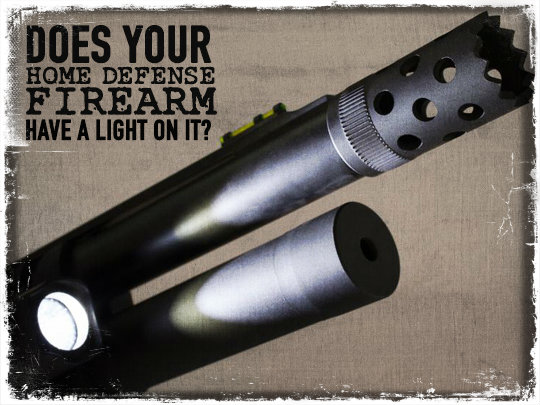
Does Your Home Defense Firearm Have A Light on It and Do You Even Need One?
If you cannot see, you cannot shoot. Family members have been killed, or injured by other family members shooting in low light, or no light conditions. Someone sees a shadow or senses movement and the trigger is pulled. Lighting up a potential target may reveal it is not a target at all.
If you cannot see what you are shooting at then you have no idea who you are shooting at.
You can of course turn on the room’s lights, but your night vision is gone once this happens and there may be an aggressor (s) in the room with you. If you turn a light on in a room and you are in the same room, then you cannot see into other darkened rooms. A tactical light mounted correctly lights up the target or the area where you suspect a target is, not the entire room, thus preserving your night vision.
Will a light give away your position, of course it will, but consider your opponent and their level of training? You are not likely going to be dealing with a team of assassins. You are defending your home, if someone is sneaking around inside your home, then you shout a warning and light up the target.
Not every homeowner that shoots an intruder gets a free pass. Pulling the trigger in many cases should be the last resort. Shooting an unarmed intruder is not an ideal situation. Granted they are in your home and they could use anything as a weapon to harm you, but you are the one with a firearm, so hold them until law enforcement arrives. Obviously if they shoot first then use, whatever force is required to neutralize the threat.
A light in the eyes of an intruder may make them reconsider, and it will ruin their night vision as well. You cannot lay in ambush, or set a trap for the intruder, you are not a sniper. You have to fear for your life and in some cases know the intruder’s intentions before firing, so being afraid of revealing your position with a light should not be a factor.
If you are clearing a room in a darkened home, then you need a light mounted on your firearm, to keep from losing your night vision. You have to have both hands on the weapon, so one hand holding a flashlight is by no means an ideal situation with a possible intruder in the house.
If someone kicks in the front door, then his or her intentions are obvious, so mounted lights may not come into play in every case. Each situation will be different and the hope is no one ever has to deal with any type of violent confrontation in his or her own home.
Make sure your firearm can be adapted so a light can be mounted in the correct manner. Taping a light to the barrel is not ideal.
Mounting a light and then putting the weapon away is not ideal either. You must practice, and become accustomed to using the light. If you mount a light and simply store the firearm away then when you do need it, the light will probably be the last thing on your mind. The light, as well as, your firearm needs to be serviced periodically whether you have used either one or not.
You need to practice until switching the light on in low or no light situations becomes natural, to where it can be done without thinking about it.
You have plenty of tactical lights to choose from, so choose carefully and make sure your weapon can be adapted for mounting a light, so you do not have to “cobble” up a system that has a greater chance of failing you.
There are low light/no-light matches around the country that a person could participate in that shows you in real time the benefits of having a light mounted on your weapon. The biggest concern with many homeowners is shooting a member of their own family that is sneaking in a window at 2am.